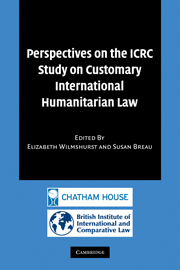Book contents
- Frontmatter
- Contents
- Preface
- List of contributors
- Table of cases
- Table of treaties and other instruments
- Abbreviations
- Part 1 Setting the scene: Theoretical perspectives on international law in the ICRC Study
- Part 2 The status of conflict and combatants: The ICRC Study
- Part 3 Commentary on selected Rules from the ICRC Study
- 6 The law of targeting
- 7 Protected persons and objects
- 8 Natural environment
- 9 Specific methods of warfare
- 10 Weapons, means and methods of warfare
- 11 Fundamental guarantees
- 12 Status and treatment of prisoners of war and other persons deprived of their liberty
- 13 Displacement and displaced persons
- 14 Implementation and compliance
- 15 War crimes
- Part 4 Conclusions
- Index
9 - Specific methods of warfare
Published online by Cambridge University Press: 09 July 2009
- Frontmatter
- Contents
- Preface
- List of contributors
- Table of cases
- Table of treaties and other instruments
- Abbreviations
- Part 1 Setting the scene: Theoretical perspectives on international law in the ICRC Study
- Part 2 The status of conflict and combatants: The ICRC Study
- Part 3 Commentary on selected Rules from the ICRC Study
- 6 The law of targeting
- 7 Protected persons and objects
- 8 Natural environment
- 9 Specific methods of warfare
- 10 Weapons, means and methods of warfare
- 11 Fundamental guarantees
- 12 Status and treatment of prisoners of war and other persons deprived of their liberty
- 13 Displacement and displaced persons
- 14 Implementation and compliance
- 15 War crimes
- Part 4 Conclusions
- Index
Summary
Introduction
Part III of the Study, although entitled ‘Specific Methods of Warfare’, embraces a miscellaneous range of topics: denial of quarter (Rules 46–48), destruction and seizure of property (Rules 49–52), starvation and access to humanitarian relief (Rules 53–56), deception (Rules 57–65), and communication with the enemy (Rules 66–69).
Treaty-based roots for the laws concerning specific methods of warfare are, for the most part, found in Hague Law provisions. The Lieber Code of 1863, which was adopted by Federal forces in the American Civil War of 1861–65 (a non-international armed conflict but one on a massive scale), prohibits the denial of quarter (Articles 60–62, 66), limits the right of one side to exercise control over the property of the other or of its nationals (Articles 31, 34–38, 44–45, 72–73), prohibits assassination (Article 148), prohibits acting in bad faith (Article 11), explicitly permits starvation as a method of war (Articles 17–18), addresses espionage and sabotage (Articles 83–84, 88, 98–100, 102, 104), permits ruses and prohibits perfidy (Article 101), and addresses modalities of communication (Articles 111–114).
The Regulations annexed to Hague Convention IV of 1907 Respecting the Laws and Customs of War on Land, which updated a similar convention adopted as Hague Convention II in 1899, also address specific methods of warfare.
- Type
- Chapter
- Information
- Publisher: Cambridge University PressPrint publication year: 2007



